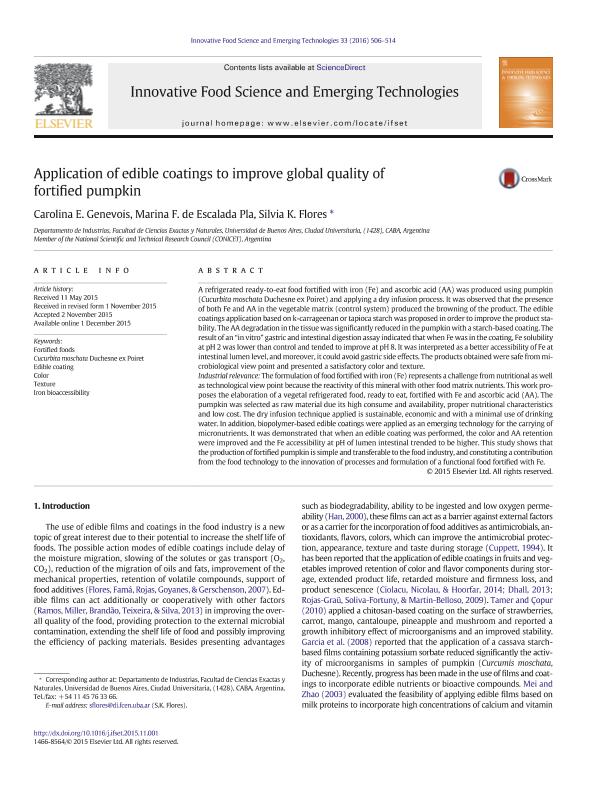Mostrar el registro sencillo del ítem
dc.contributor.author
Genevois, Carolina Elizabeth

dc.contributor.author
de Escalada Pla, Marina Francisca

dc.contributor.author
Flores, Silvia Karina

dc.date.available
2018-09-13T18:53:08Z
dc.date.issued
2016-02
dc.identifier.citation
Genevois, Carolina Elizabeth; de Escalada Pla, Marina Francisca; Flores, Silvia Karina; Application of edible coatings to improve global quality of fortified pumpkin; Elsevier; Innovative Food Science & Emerging Technologies; 33; 2-2016; 506-514
dc.identifier.issn
1466-8564
dc.identifier.uri
http://hdl.handle.net/11336/59586
dc.description.abstract
A refrigerated ready-to-eat food fortified with iron (Fe) and ascorbic acid (AA) was produced using pumpkin (Cucurbita moschata Duchesne ex Poiret) and applying a dry infusion process. It was observed that the presence of both Fe and AA in the vegetable matrix (control system) produced the browning of the product. The edible coatings application based on k-carrageenan or tapioca starch was proposed in order to improve the product stability. The AA degradation in the tissue was significantly reduced in the pumpkin with a starch-based coating. The result of an "in vitro" gastric and intestinal digestion assay indicated that when Fe was in the coating, Fe solubility at pH 2 was lower than control and tended to improve at pH 8. It was interpreted as a better accessibility of Fe at intestinal lumen level, and moreover, it could avoid gastric side effects. The products obtained were safe from microbiological view point and presented a satisfactory color and texture. Industrial relevance The formulation of food fortified with iron (Fe) represents a challenge from nutritional as well as technological view point because the reactivity of this mineral with other food matrix nutrients. This work proposes the elaboration of a vegetal refrigerated food, ready to eat, fortified with Fe and ascorbic acid (AA). The pumpkin was selected as raw material due its high consume and availability, proper nutritional characteristics and low cost. The dry infusion technique applied is sustainable, economic and with a minimal use of drinking water. In addition, biopolymer-based edible coatings were applied as an emerging technology for the carrying of micronutrients. It was demonstrated that when an edible coating was performed, the color and AA retention were improved and the Fe accessibility at pH of lumen intestinal trended to be higher. This study shows that the production of fortified pumpkin is simple and transferable to the food industry, and constituting a contribution from the food technology to the innovation of processes and formulation of a functional food fortified with Fe.
dc.format
application/pdf
dc.language.iso
eng
dc.publisher
Elsevier

dc.rights
info:eu-repo/semantics/openAccess
dc.rights.uri
https://creativecommons.org/licenses/by-nc-nd/2.5/ar/
dc.subject
Color
dc.subject
Cucurbita Moschata Duchesne Ex Poiret
dc.subject
Edible Coating
dc.subject
Fortified Foods
dc.subject
Iron Bioaccessibility
dc.subject
Texture
dc.subject.classification
Alimentos y Bebidas

dc.subject.classification
Otras Ingenierías y Tecnologías

dc.subject.classification
INGENIERÍAS Y TECNOLOGÍAS

dc.title
Application of edible coatings to improve global quality of fortified pumpkin
dc.type
info:eu-repo/semantics/article
dc.type
info:ar-repo/semantics/artículo
dc.type
info:eu-repo/semantics/publishedVersion
dc.date.updated
2018-09-13T13:16:05Z
dc.journal.volume
33
dc.journal.pagination
506-514
dc.journal.pais
Países Bajos

dc.journal.ciudad
Amsterdam
dc.description.fil
Fil: Genevois, Carolina Elizabeth. Universidad de Buenos Aires. Facultad de Ciencias Exactas y Naturales. Departamento de Industrias; Argentina. Consejo Nacional de Investigaciones Científicas y Técnicas; Argentina
dc.description.fil
Fil: de Escalada Pla, Marina Francisca. Universidad de Buenos Aires. Facultad de Ciencias Exactas y Naturales. Departamento de Industrias; Argentina. Consejo Nacional de Investigaciones Científicas y Técnicas; Argentina
dc.description.fil
Fil: Flores, Silvia Karina. Universidad de Buenos Aires. Facultad de Ciencias Exactas y Naturales. Departamento de Industrias; Argentina. Consejo Nacional de Investigaciones Científicas y Técnicas; Argentina
dc.journal.title
Innovative Food Science & Emerging Technologies

dc.relation.alternativeid
info:eu-repo/semantics/altIdentifier/doi/http://dx.doi.org/10.1016/j.ifset.2015.11.001
dc.relation.alternativeid
info:eu-repo/semantics/altIdentifier/url/https://www.sciencedirect.com/science/article/pii/S1466856415002143
Archivos asociados
